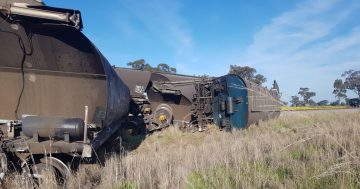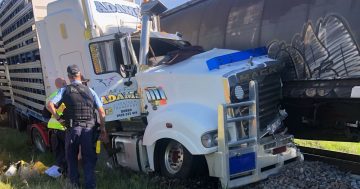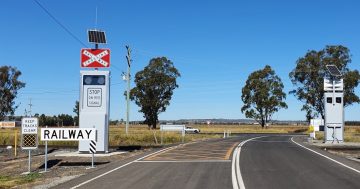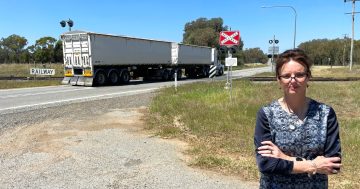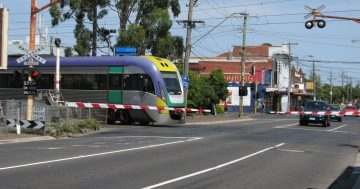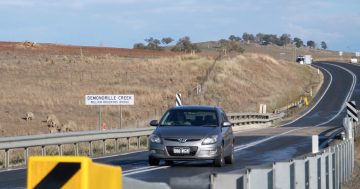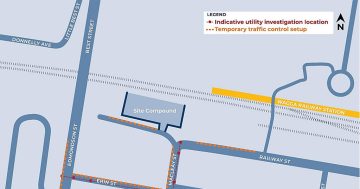
A train derailed at Old Junee in March 2023 after colliding with a grain truck on a level crossing. Photo: Jarryd Rowley.
With railway crossings at Old Junee and Caragabal among 23 targeted for prioritised safety improvements, and a rail safety trial underway on Mary Gilmore Way at Bribbaree, there are hopes a railway level-crossing summit in Brisbane today (6 March) will deliver more federal funds to improve level-crossing safety across southern NSW.
First in line for that assurance will be Member for Cootamundra Steph Cooke, who recently voiced her concerns about delays to the upgrade of a level crossing on Goldfields Way at Old Junee. The work was scheduled to be finished late last year.
Ms Cooke said she was pleased NSW Regional Transport Minister Jenny Aitchison had considered these concerns and included Old Junee among priority projects across NSW to share in federal funding aimed at enhancing safety at high-risk level crossings.
”Level crossing safety continues to be a major issue out here in the regions, including at a number of locations here in our Cootamundra electorate,” she said.
“We’ve seen some positive news in our local area recently with the crossings on Goldfields Way and at Caragabal, but there’s always more to be done; we need a greater focus and more investment on keeping drivers safe, whether it’s local families on the school run, heavy-freight operators transporting goods in and out of the area, or those on board the trains.”
Ms Cooke said she would continue to shine a light on the issue.
“Once again, I encourage the Regional Transport Minister to visit the region and see for herself the issues that continue to plague our problem spots, and to make the safety of our communities a top priority for 2024,” she said.
Ahead of today’s summit, Ms Aitchison said she was focused on ensuring the NSW Government was doing everything it could to improve safety, including looking at the rolling stock and better education for drivers.
“This is not a problem NSW can save on its own. I really want NSW to be part of the solution and working directly with the rolling-stock operators, the rail infrastructure managers, the Commonwealth and other state governments to come to achieve real progress on this issue,” she said.
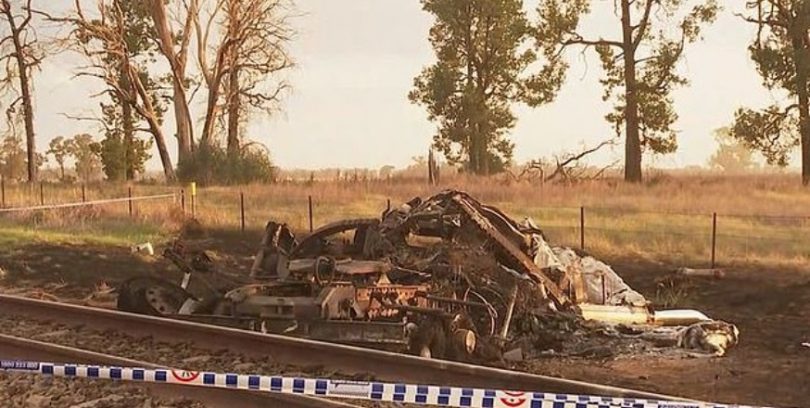
Two men were killed when their truck collided with a freight train west of Bribbaree in February 2021. Photo: Supplied.
Also seeking assurances is the Rail, Tram and Bus Union (RTBU). At today’s roundtable, it will be seeking mandatory safety cameras at level crossings and increased penalties for drivers who cross in front of a train.
RTBU assistant national secretary Shayne Kummerfeld said significant decisions needed to be made for the safety of both rail workers and road users.
“Motorists are continuing to drive straight through level crossings in front of trains,” he said.
“The rail industry has been talking about level crossing safety for years, but the tragedies keep happening. It’s time for authorities to take a zero tolerance,” Mr Kummerfeld said.
The use of additional engineering controls alerting road users to the need to stop would almost certainly provide an enhanced level of safety at level crossings, according to the Australian Transport Safety Bureau (ATSB).
In a report released yesterday, ahead of the summit, an ATSB analysis of 49 level-crossing collisions involving heavy vehicles between July 2014 and August 2022 found that obstructed views or failure to detect oncoming trains contributed to most accidents.
The report comes out of an ATSB study into the risks associated with level-crossing collisions. It set out to compare the severity of level-crossing collisions involving heavy road vehicles with those involving light road vehicles.
ATSB chief commissioner Angus Mitchell said the analysis confirmed collisions involving heavy road vehicles were more common and more dangerous.
The report found in at least 12 of the collisions, the heavy-vehicle driver had regularly used the level crossing before the collision with the train.
In at least 14 incidents, the driver’s view of the track or level-crossing protection equipment was obstructed by vegetation, the design of the heavy-vehicle cab, poor crossing lighting, or sun glare.
And in at least 14 accidents, it was likely the driver intentionally entered the level crossing in a manner contrary to road rules, with the intention to proceed through the crossing before the train arrived.
The study also revealed that in most accidents at passively controlled crossings (those without flashing lights or boom gates), heavy-vehicle drivers did not detect the train or detected the train too late to avoid a collision.
Mr Mitchell said level-crossing collisions involving heavy vehicles were more likely to lead to injuries to the occupants of rail vehicles, damage to rail vehicles and track, and the derailment of rail vehicles.
He said improvements would be made by reducing the reliance on road vehicle drivers detecting the presence of trains.
“Safety at passive crossings relies on motor vehicle drivers looking for and identifying trains, and the collisions analysed in our study primarily resulted from the presence of trains not being detected, being detected late, or being perceived incorrectly,” Mr Mitchell said.
“We know that humans are inherently susceptible to unintentional errors. And so long as passively controlled level-crossing safety systems rely on road vehicle drivers always detecting the presence of trains, it is certain that this will fail from time to time and result in accidents in the future.”
The study has also led to a review by Standards Australia to determine whether additional design guidance for the installation of level-crossing protection equipment can be provided to manage risks associated with curved road approaches to the crossings.
Original Article published by Edwina Mason on About Regional.







